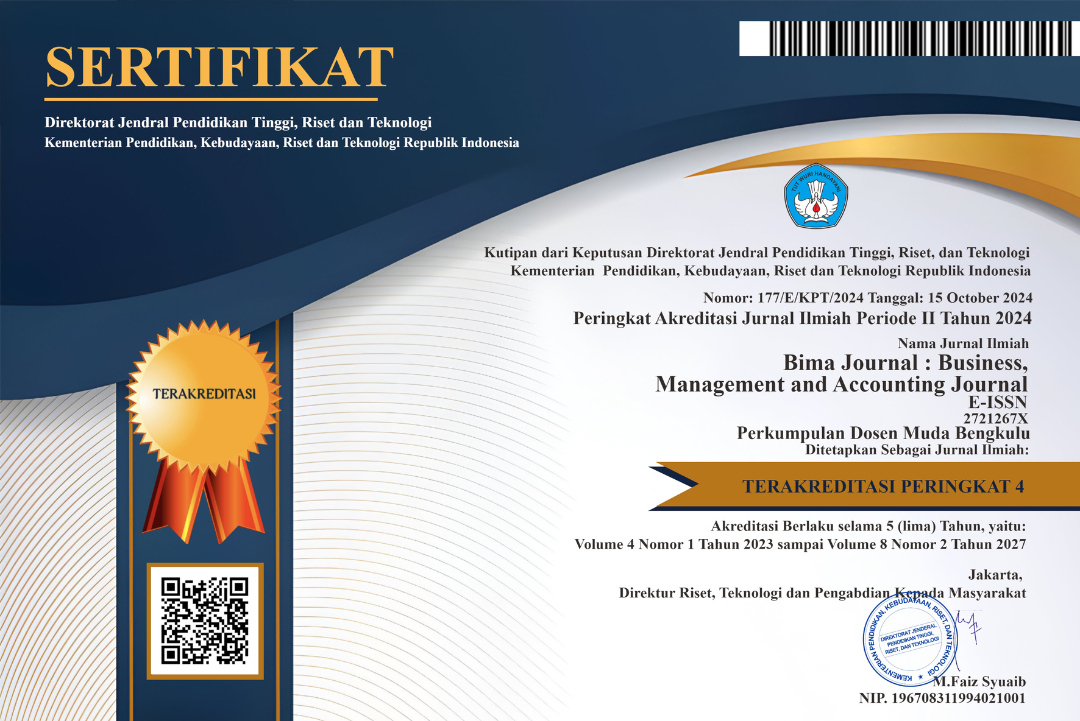The Influence Of Motivation And Discipline On The Work Productivity Of Employees In Camat Office Of Sukaraja District, Seluma Province, Bengkulu Province
DOI:
https://doi.org/10.37638/bima.2.1.1-12Keywords:
Motivation, Work Discipline, Work ProductivityAbstract
The purpose of this study was to determine factors such as motivation and work discipline tahat affect the work prductivity of employees at the Head Office of Sukaraja District, Seluma Regency. The sample in this study was 29 employees at the Head Office of Sukaraja District, Seluma Regency. Data collectiion using a questionnaire and the method of analysis used is multiple linear regression, test of determination and hypothesis testing. The result of the regression equation is Y = n10,107 + 0,417 X1 + 0,361X2 + e, which means that motivation and work discipline have a positive influence of the work productivity of employees at the Head Office of Sukaraja District, Seluma Regency. The results of the determination test was 0,567 0r (56,7%). This shows that motivation and work discipline have an effect on the work productivity of employees at the Subdistrict Head Office of Sukaraja District, Seluma Regency by 56,7 % while the rest are explained or influenced by other variables not examined.
References
Anwar, Ali. 2009. Statistika Untuk Penelitian Dan Aplikasinya Dengan SPSS & Excel. Bandung: Alfabeta. ISSN: 1098-6596
Darsono Dan Tjatjuk, Siswandoko. 2011. Manajemen Sumber Daya Manusia Abad 21. Jakarta: Nusantara Consulting.ISBN: 978-602-950-305-0
Ghozali, Imam. 2013. Aplikasi Analisis Multivariat Dengan Program IBM SPSS. Vol. 53. Edisi 7. Semarang: Penerbit Universitas Diponegoro.ISBN: 9788578110796
Ghozali, Imam. 2016. Aplikasi Analisis Multivariete Dengan Program IBM SPSS 23. Edisi 8. Semarang: Badan Penerbit Universitas Diponegoro.
Hasibuan, Malayu SP. 2016. Manajemen Sumber Daya Manusia. Jakarta: PT Bumi Aksara.ISBN: 979-526-491-5
Latham, Gary P., and Craig C. Pinder. 2005. “Work Motivation Theory and Research at the Dawn of the Twenty-First Century.” Annual Review of Psychology 56(June):485–516.
Maduka, Chukwuma Edwin, and Obiefuna Okafor. 2014. “Effect of Motivation on Employee Productivity: A Study of Manufacturing Companies in Nnewi.” International Journal of Managerial Studies and Research 2(7):137–47.
Mangkunegara, A. A.Anwar Prabu. 2016. Manajemen Sumber Daya Manusia Perusahaan. Bandung: PT Remaja Rosdakarya. ISBN: 979-514-929-6
Martin, Andrew J., and Martin Dowson. 2009. “Interpersonal Relationships, Motivation, Engagement, and Achievement: Yields for Theory, Current Issues, and Educational Practice.” Review of Educational Research 79(1):327–65.
Nitisemito, Alex S. 2014. Manajemen Personalia. Jakarta: Ghalia Indonesia.
Nurmansyah. 2011. Manajemen Sumber Daya Manusia Suatu Pengantar. Pekabaru: Unilak Press.
Siagian, Sondang P. 2014. Manajemen Sumber Daya Manusia. Jakarta: Bumi Aksara. ISBN: 979-526-100-2
Simamora, Henry. 2016. Manajemen Sumber Daya Manusia In Manajemen Sumber Daya Manusia. Jakarta: Kencana Pranada Media Group.ISBN: 9786025867255
Sugiono. 2015. Statistika Untuk Penelitian. Alfabeta.
Sutrisno, Edy. 2011. Manajemen Sumber Daya Manusia. Jakarta: Kencana Pranada Media Group. ISBN: 9789791486767
Downloads
Published
Issue
Section
License
An author who publishes in the BIMA JOURNAL: Business, Management, and Accounting Journal agrees to the following terms:
Author retains the copyright and grants the journal the right of first publication of the work simultaneously licensed under the Creative Commons Attribution-ShareAlike 4.0 License that allows others to share the work with an acknowledgement of the work's authorship and initial publication in this journal
Submission of a manuscript implies that the submitted work has not been published before (except as part of a thesis or report, or abstract); that it is not under consideration for publication elsewhere; that its publication has been approved by all co-authors. If and when the manuscript is accepted for publication, the author(s) still hold the copyright and retain publishing rights without restrictions. For the new invention, authors are suggested to manage its patent before published. The license type is CC-BY-SA 4.0.
BIMA JOURNAL: Business, Management and Accounting is licensed under a Creative Commons Attribution-ShareAlike 4.0 International License.
You are free to:
Share — copy and redistribute the material in any medium or format
Adapt — remix, transform, and build upon the material
for any purpose, even commercially.
The licensor cannot revoke these freedoms as long as you follow the license terms.
Under the following terms:
Attribution — You must give appropriate credit, provide a link to the license, and indicate if changes were made. You may do so in any reasonable manner, but not in any way that suggests the licensor endorses you or your use.
ShareAlike — If you remix, transform, or build upon the material, you must distribute your contributions under the same license as the original.
- No additional restrictions — You may not apply legal terms or technological measures that legally restrict others from doing anything the license permits.
Notices:
- You do not have to comply with the license for elements of the material in the public domain or where your use is permitted by an applicable exception or limitation.
- No warranties are given. The license may not give you all of the permissions necessary for your intended use. For example, other rights such as publicity, privacy, or moral rights may limit how you use the material.





















